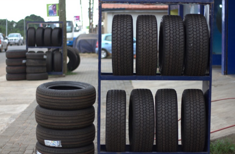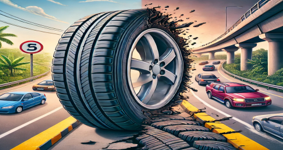By Eddie POKU
Ghana’s love affair with used tires is no secret. Everywhere you look, vehicles—sometimes even low-mileage ones—are rolling on second-hand rubber.
This is not just a small trend; it has become an entire industry, with businesses dedicated to importing and selling used tires. The government, of course, gets its share of the pie through duties and taxes, but at what cost to road safety?
While many vehicle owners cite affordability as the main reason for choosing used tires, the reality is far more complicated. Having personally run used tires on my vehicle before switching to new ones, I can confidently say that the perceived savings are a myth.
In most cases, you’ll end up replacing used tires three or four times before a single set of new tires would need changing. That is not saving money—it is just spreading out the expense while compromising safety.
Used tires might seem like a budget-friendly alternative, but they come with a long list of hidden dangers. Here is why choosing second-hand rubber might not be the smartest decision:
Unknown History
Used tires have been through a lot—overloading, underinflation, high-speed stress, or even undisclosed repairs. Their past is a mystery, and that alone makes them unreliable.
Reduced Grip & Tread Wear
Worn-out tread means poor traction, longer braking distances, and a higher risk of skidding, especially in wet conditions. Do you really want to take that gamble on Ghana’s unpredictable roads?
Structural Weakness
Beneath the surface, older tires may have hidden damage—belt separation, sidewall cracks, or even internal punctures—making them prone to sudden blowouts. Imagine that happening at highway speeds.
Aging Rubber
Even if a tire looks fine, rubber degrades over time. Old tires become brittle and less elastic, increasing the likelihood of cracks and failure. Would you trust a decade-old rope to hold your weight?
Performance Inconsistency
Mixing different brands, tread patterns, or tire ages can lead to uneven handling and instability. Your car’s suspension takes a beating, and before you know it, you’re spending more on repairs.
Lower Fuel Efficiency
Worn-out or poorly balanced tires increase rolling resistance, meaning your car needs to work harder—and burn more fuel—to move. That extra fuel cost. It adds up quickly.
Serious Safety Risks
A tire failure at high speeds or during an emergency maneuver can lead to a serious accident. No amount of savings is worth putting lives at risk.
Shorter Lifespan
Used tires will not last long. Whatever you save initially will likely be spent replacing them sooner than you would a set of new ones.
Potential Legal and Insurance Issues
Driving with unsafe tires can lead to fines, vehicle inspection failures, or even rejected insurance claims if an accident occurs. Some insurers may not cover accidents caused by worn-out tires.
The good news? These days, there are plenty of reasonably priced new tires on the market. They last longer, perform better, and most importantly, keep you safer on the road.

Investing in new tires is not just about saving money in the end—it is about protecting yourself, your passengers, and other road users. So, the next time you are tempted to buy used tires, ask yourself: is it really worth it? A little more upfront can save you a whole lot down the road—literally.










